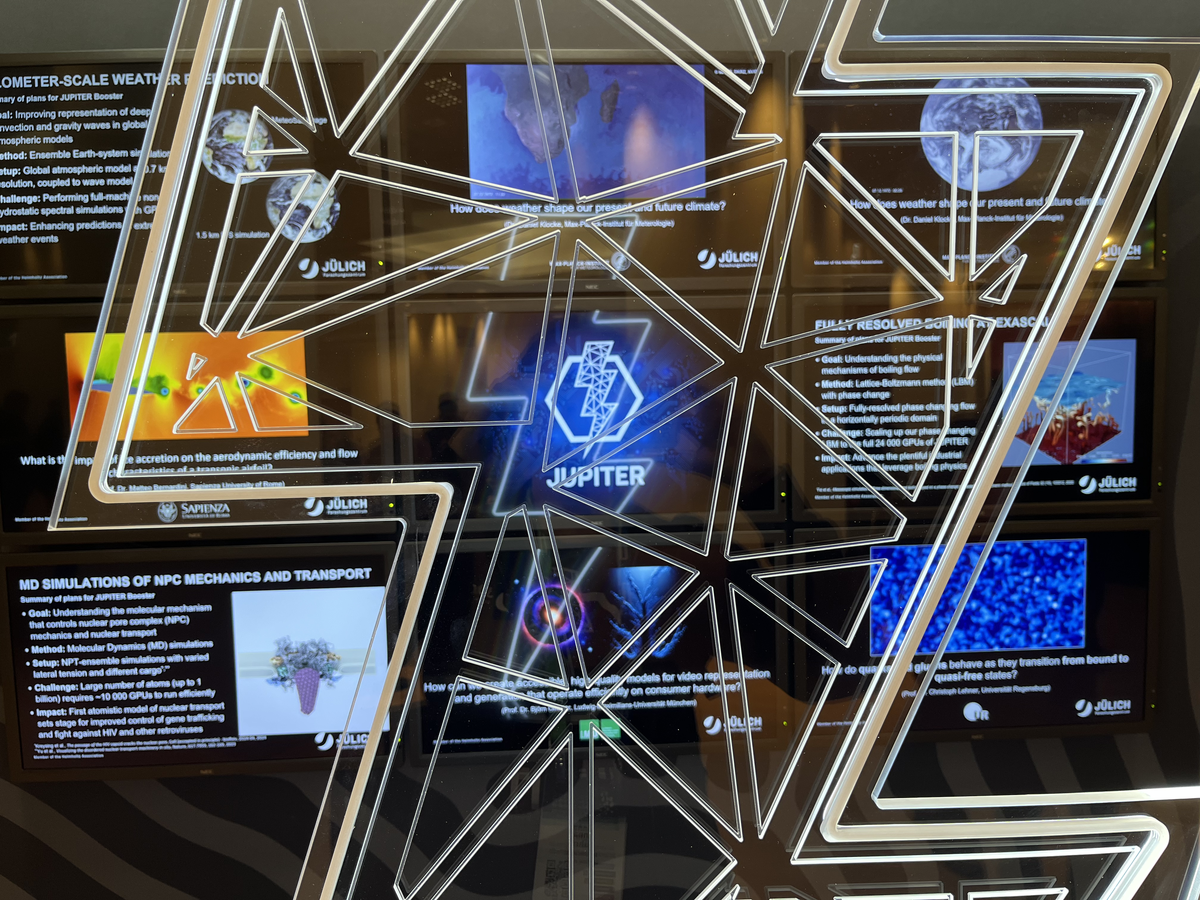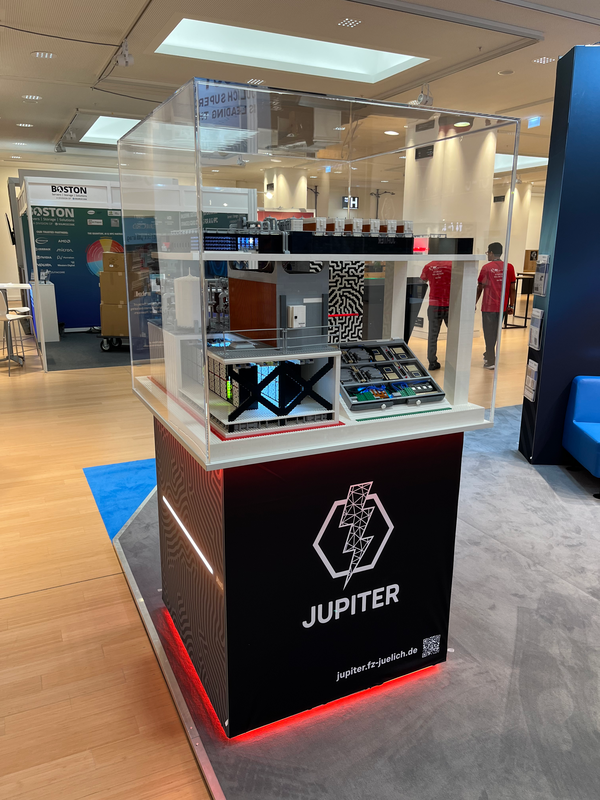ISC25: Action-packed days dedicated to JUPITER, quantum power, and networking
Blue skies, bright sunshine, and a long line of people in front of the Congress Center Hamburg (CHH). ISC25 kicks off and, in perfect June weather, attracts more than 3,500 scientists, researchers, experts, students, engineers, analysts, and journalists to the exhibition hall just one day after Pentecost. Among them are around 40 JSC employees, easily recognizable in the crowd by their “JUPITER” jackets with the FZJ logo on the front and a huge lightning bolt on the back.
Thanks to perfect organization, everything runs smoothly and everyone attending the international conference on high-performance computing, AI, data analysis, and quantum computing from June 10 to 13 is rewarded with a great program and excellent catering. ISC High Performance is celebrating its 40th anniversary, and for the first time, the JSC is represented at two exhibition stands (among the approximately 150 exhibitors): Traditionally at the joint booth of the Gauss Centre for Supercomputing (GCS) and at its own JUPITER booth.

JUPITER: THE ARRIVAL OF EXASCALE
For the JSC, the conference begins with a bang: the announcement of the Top500 list and its winners is scheduled for day one. Twice a year, it presents the 500 fastest supercomputers in the world. JUPITER, which was developed by JSC and built at Forschungszentrum Jülich in only six months, has made it to 4th place as a newcomer and is also the fastest supercomputer in Europe. And it has not even reached its full potential yet – when fully expanded in a few weeks, it will be the first supercomputer in Europe to break the 1 exaFLOP/s mark. Prof. Thomas Lippert and Prof. Kristel Michielsen accept the certificate in person. Thomas Lippert also gives a presentation on JUPITER on behalf of Kristel Michielsen, Anders Jensen (EuroHPC), and Emanuel le Roux (EVIDEN), reporting on the beginnings, the rapid journey, and what is planned for JUPITER.
JEDI, the JUPITER Exascale Development Instrument, impresses once again: It successfully defended its first place on the Green500 list. What’s more, among the top 5, JUPITER is the most energy-efficient supercomputer on this list.

LEGO? YEP!
The JUPITER booth is buzzing with energy: Visitors learn about the "lighthouse" projects that can be realized with JUPITER or take a virtual reality tour of the Modular Data Centre, MCD, (including a view from the roof, where the impressive cooling modules are located). They watch JUPITER videos and find out about the JUPITER AI Factory (JAIF), or take a look at the popular monitoring tool LLview, which provides a live insight into ongoing computing jobs on the supercomputers. A real crowd-puller is the LEGO model of the MDC built for the supercomputer. It shows the entire MDC, a double container with JUPITER blades inside and cooling technology on the roof, a single large JUPITER rack, and a blade in detail—and is the object of great admiration. JSC employees are frequently approached with the question: “Is this the LEGO model I heard about?!”

JSC at the GCS booth: Focus on quantum computing
This year, the JSC’s focus at the GCS booth is on quantum computing. Not only because 2025 is the Year of Quantum, but also because the two booths automatically form two different focal points. The prominent JUPITER display in the foyer of the exhibition attracts those who are enthusiastic about supercomputing and exascale, while those interested in quantum computing are drawn to the Jülich section of the GCS booth. In line with this, the growing “JUelicher User Infrastructure for Quantum Computing (JUNIQ)” is also being presented here. Moreover, experts from Pasqual and D-Wave, both providers of different quantum computing systems, give technical presentations.

JSC is present in all formats: from panels, talks, and BoFs to “Meet and Greet”
JSC employees are everywhere at the conference: they are busy at their own booths, representing their centre, and elsewhere: connecting with others. They are on stage or sitting in the audience at keynotes, sessions, or workshops. They present their topics or learn about those of others – alongside JSC’s slogan “Unleashing Next-Gen Computing Power,” the ISC’s “Connecting the dots” is also our motto here.
One of many highlights is the discussion panel “HPC in Europe,” where Prof. Kristel Michielsen, head of JUNIQ and quantum computing at JSC, is among those invited. She is preceded by Anders Jensen, Executive Director of the European High Performance Computing Joint Undertaking (EuroHPC JU), who dives right into the topic of JUPITER. He says that this has been foreseeable ever since EuroHPC was founded and calls it a fantastic achievement. Jensen explains the role of EuroHPC and the strong desire to “put Europe back on the map.” What he implies is that Europe should (once again) take a leading role in the world. He mentions the AI Factories, which are intended to fuel European research and innovation, and talks about closer international cooperation and the goal of technical sovereignty for Europe.

"JUPITER IS CLOSING IN"
Kristel Michielsen picks up perfectly on this with “JUPITER is closing in.” She focuses on the journey that JUPITER has taken since the first discussions between many of those involved. “It's not a straight path, there have been a few bumps along the way,” Michielsen admits. And yet her presentation quickly reveals how many milestones JUPITER has already reached (and set) along the way – and how close it is to achieving its goal of 1 exaFLOP/s. Kristel Michielsen also makes it very clear that JUPITER is designed for two areas of application: high-performance computing and AI training. She emphasizes the European technology used in parts of JUPITER, shows pictures of the construction site – from the start of construction to the present day – mentions the top rankings on the Top500 and Green500 lists, and thanks her team, without whom JUPITER would not be where it is today.
Research Poster Awards: 2nd place goes to JSC
Presentations, discussions, and introductions are also taking place elsewhere: JSC colleagues host “meet and greet” events, “sofa” and “booth” talks, as well as “birds of a feather” sessions. Some of our colleagues are also involved in the “Women in HPC” network. JSC staff also appears at the EuroHPC booth, for example for presentations on JUPITER (Andreas Herten) and the JUPITER AI Factory (Mathis Bode). And, of course, our scientists give workshops and tutorials and present their papers and posters – with great success. With “The Art of Process Pinning – Turning Chaos into Core Harmony,” our colleagues Thomas Breuer, Wolfgang Frings, Jens Henrik Göbbert, Filipe Souza Mendes Guimarães, Carina Himmels, and Chrysovalantis Paschoulas even took 2nd place in the ISC Research Poster Awards.

Takeaway: Another amazing conference experience
An exhibition is only as good as its exhibitors, a conference program is only as good as its speakers, and an audience is only as good as its participants. A huge THANK YOU to our JSC colleagues on site and behind the scenes, our trade fair stand builder (WWM GmbH & CO. KG), our LEGO builder Rene Hoffmeister (BrickFabrik), our cooperation partners and sponsors, and everyone who visited us! See you next time!

